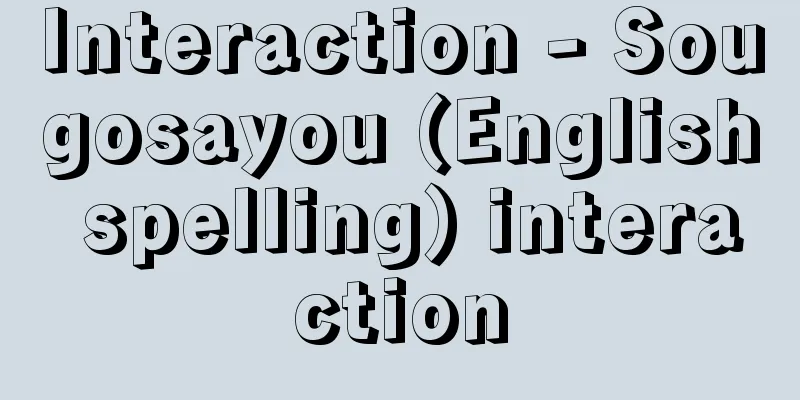Interaction - Sougosayou (English spelling) interaction

|
If we call the particles that are the basic elements that make up matter, and the particles that mediate the interactions between these particles, elementary particles are collectively called elementary particles. The interaction between elementary particles is the cause of the mutual transformation, which is the most important characteristic of elementary particles. To describe the mutual transformation of particles, it is appropriate to consider it from the standpoint that each elementary particle is created and annihilated as a quantum of each field (quantum field theory). Since ordinary forces are generated by the exchange of mediator particles (a form of creation and annihilation), interaction is a more general and fundamental concept than force. Interactions between elementary particles are based on interactions between basic fields. As a result, matter is formed and forces between material particles arise. The elementary interactions are usually classified into four types of interactions with clearly different strengths, namely, (1) strong interaction, (2) electromagnetic interaction, (3) weak interaction, and (4) gravitational interaction. [Ryozo Tamagaki and Tsuneo Uematsu] Electromagnetic InteractionThe mediating particle of electromagnetic interaction is the photon, a quantum of the electromagnetic field. Its range is infinite because the photon has zero mass. The interaction is expressed as a product of two four-dimensional vectors, the electromagnetic potential and the current, with the elementary charge e as a coefficient, and the coupling constant is the fine structure constant (dimensionless, with a value of approximately 1/137). Atoms and molecules are formed through electromagnetic interaction. [Ryozo Tamagaki and Tsuneo Uematsu] Strong interactionsAmong the strong interactions, the nuclear force that binds atomic nuclei plays an important role in the formation of the natural world. The reach of the strong interaction is short, about 1 femtometer (1/1000 trillionths of a meter), which is close to the Compton wavelength of the π meson. The coupling constant (a dimensionless value) varies slightly depending on the combination of particles, but is about 100 times the fine structure constant, i.e., about 1. In general, the strong interaction is expressed in terms of the Yukawa-type coupling between baryons (a general term for heavy particles similar to nucleons) and the meson field of the intermediate particle. Hadrons (elementary particles that have strong interactions) are made of quarks and are in a "colorless" state with respect to the degree of freedom of "color" (internal degrees of freedom different from those traditionally considered such as spin and charge, and symbolically called "color"), and this degree of freedom of "color" is the source of the strong interaction. [Ryozo Tamagaki and Tsuneo Uematsu] weak interactionWeak interactions cause transition processes involving leptons (a collective term for electrons, muons, neutrinos, etc., also known as light particles) such as in the beta decay of atomic nuclei, as well as slow decay processes of elementary particles that do not involve leptons. The reach of the interaction is extremely small, less than one-hundredth of a femtometer, and the coupling constant is small, about one-hundred-thousandth. Weak interactions are summarized in the form of a product of four-dimensional currents consisting of lepton and hadronic parts (called the Fermi type), and the coupling constant is universal regardless of the combination of particles involved. Since hadrons are made of quarks, the hadronic part of the interaction described in this way should be described in the quark field, and the interconversion of elementary particles through the weak interaction is described based on quarks and leptons. [Ryozo Tamagaki and Tsuneo Uematsu] Gravitational InteractionGravitational interactions are extremely small between elementary particles with small masses; for example, the gravitational potential between two protons one femtometer apart is about 10 -38 times smaller than the nuclear force, which can be considered as the relative ratio of the coupling constant. However, on a macroscopic scale, the contributions from all particles are additive, so the effect is large. The theory of gravity is based on Einstein's general theory of relativity, which is based on the idea that time and space are not simply "containers" but have mechanical content related to the existence of matter. According to this, the existence of gravitational interactions is implied by the fact that the metric tensor is not a constant. [Ryozo Tamagaki and Tsuneo Uematsu] Unified InteractionWith the development of particle physics, the basic building blocks of matter have been recognized as quarks and leptons, and the possibility of a unified description of their basic interactions has been opened up. The Weinberg-Salam model of weak electromagnetic unification, proposed in 1967, was the starting point. Gauge fields of triads (W + , W - , W 0 ) and another B 0 are introduced as fundamental fields. W ± bosons mediate the weak interaction with electric charge. The superposition of W 0 and B 0 produces photons and Z 0 bosons, the former of which mediates the electromagnetic interaction and the latter of the weak interaction due to neutral current. Gauge fields generally correspond to massless vector particles, but due to the Higgs mechanism (the gauge bosons have mass due to spontaneous symmetry breaking), W ± and Z 0 have large masses (about 90 times that of a proton), so the weak interaction at low energies appears extremely different from the electromagnetic interaction. The weak and electromagnetic unified theory was experimentally confirmed in 1973 with the neutral current reaction, and in 1983 with W ± and Z 0. In the 1970s, it was expected that the strong interaction would be described by the quantum chromodynamics of quarks and gluons, with the gluon field (eight types of vector fields corresponding to the three colors of quarks) acting as a gauge field, mediating the degree of freedom of the "colors". Research was then advanced to describe the strong interaction and the weak and electromagnetic interactions in a unified manner within a common framework called non-Abelian gauge theory. When the energy reaches about 10 15 GeV (about 1000 trillion times the rest energy of the proton), the previously differentiated interactions have a common strength. This framework, called the Grand Unified Theory, includes interactions that do not conserve the baryon number, and predicts that the proton is unstable (although it has a long life of about 10 31 years). Experimental research into proton decay has been carried out since around 1980, and it is believed to have a lifespan of more than 1033 years, but as of 2013, proton decay has not yet been observed. This theory also offers the possibility of understanding the origin of matter in the universe (particle-antiparticle asymmetry). Furthermore, since the theory of gravity can also be formulated as a gauge theory, it is expected that in the future it will be possible to describe the four fundamental interactions from a unified perspective and method, and attempts to construct such a theory are underway. [Ryozo Tamagaki and Tsuneo Uematsu] "Basic Physics Selection: Elementary Particles" by Takeda Akira (1986, Shokabo)" ▽ "Elementary Particle Physics" by Maki Jiro and Hayashi Koichi (1995, Maruzen)" ▽ "Another Introduction to Elementary Particle Theory" by Maskawa Toshihide, edited by Otsuki Yoshihiko, Parity Editorial Committee (1998, Maruzen)" ▽ "What is the Universe Made of? Solving the Mysteries of the Universe with Elementary Particle Physics" by Murayama Hitoshi (Gentosha Shinsho)" [References] | | | | | |Source: Shogakukan Encyclopedia Nipponica About Encyclopedia Nipponica Information | Legend |
|
物質を構成する基本的な要素としての粒子、およびこの粒子間の作用を媒介する粒子をまとめて素粒子とよべば、素粒子のもっとも重要な特徴である相互転化の原因となるのが素粒子間の相互作用である。粒子の相互転化を記述するには、個々の素粒子はそれぞれの場の量子として生成・消滅するという立場(場の量子論)からとらえるのが適当である。通常の力は媒介粒子の交換(生成・消滅の一つの形態)により生ずるので、相互作用は力よりも一般的で基礎的な概念である。素粒子間の相互作用は、基本となる場の間の相互作用に基づいている。その結果として物質が形成され、物質粒子間の力が生じてくる。基本相互作用は通常、強さが画然と異なった4種の相互作用、すなわち、(1)強い相互作用、(2)電磁相互作用、(3)弱い相互作用、(4)重力相互作用に分類される。 [玉垣良三・植松恒夫] 電磁相互作用電磁相互作用の媒介粒子は、電磁場の量子である光子である。その到達距離は、光子の質量が0であるため無限大である。相互作用は、二つの四次元ベクトル、電磁ポテンシャルと電流の積に電気素量eが係数となる形式で表され、結合定数は微細構造定数(無次元で約137分の1の値)である。原子、分子は電磁相互作用で形成される。 [玉垣良三・植松恒夫] 強い相互作用強い相互作用のなかで自然界の形成に重要な役割を果たすのは、原子核の結合を与える核力である。強い相互作用の到達距離は短く、π(パイ)中間子のコンプトン波長に近い1フェムトメートル(1000兆分の1メートル)程度である。結合定数(無次元化された値)は粒子の組合せで若干変動するが、微細構造定数の約100倍、すなわち1程度である。一般に強い相互作用は、バリオン(核子と同族の重い粒子の総称)と媒介粒子の中間子の場の間の湯川型結合を基本形として表される。ハドロン(強い相互作用をする素粒子)がクォークからなり、「色」の自由度(スピンや荷電など従来考えられてきたものとは別の内部自由度で、象徴的な意味で「色」という)について「無色」の状態であり、この「色」の自由度が強い相互作用の源泉である。 [玉垣良三・植松恒夫] 弱い相互作用弱い相互作用は、原子核のβ(ベータ)崩壊におけるようにレプトン(電子、μ(ミュー)粒子、ニュートリノなどの総称。軽粒子ともいう)が関与する遷移過程、およびレプトンが関与しない素粒子の遅い崩壊過程を引き起こす。相互作用の到達距離は100分の1フェムトメートル以下と極端に小さく、結合定数は10万分の1程度と小さい。弱い相互作用は、レプトン部分とハドロン部分からなる四次元の流れ(カレント)の積の形式(フェルミ型とよぶ)にまとめられ、結合定数は関与する粒子の組合せによらない普遍性をもっている。ハドロンがクォークからできているので、このように表された相互作用のハドロン部分はクォークの場で記述されるべきもので、弱い相互作用による素粒子の相互転化は、クォークとレプトンを基にして記述されることになる。 [玉垣良三・植松恒夫] 重力相互作用重力相互作用は、質量が小さい素粒子間ではきわめて小さく、たとえば互いに1フェムトメートル離れた二つの陽子間の重力ポテンシャルは核力に比して10-38倍程度小さく、これが結合定数の相対比とみなせる。しかし、巨視的スケールでは、すべての粒子からの寄与が加算的となるので、大きい効果をもたらす。重力の理論は、時間・空間が単なる「入れ物」ではなく物質の存在とかかわる力学的内容をもつとの考えに基づくアインシュタインの一般相対性理論に基礎を置いている。これによれば、計量テンソルが定数でないことが重力相互作用の存在を意味している。 [玉垣良三・植松恒夫] 相互作用の統一素粒子物理学の進展によって、物質の基本構成要素がクォークとレプトンであるとの認識が確立するとともに、これらの基本相互作用の統一的記述の可能性が開けてきた。まず、1967年に提唱された弱・電磁統一理論のワインバーグ‐サラム模型がその端緒となった。ゲージ場として三つ組(W+、W-、W0)ともう一つのB0が基本的な場として導入される。W±ボソンは荷電を伴う弱い相互作用を媒介する。W0とB0の重ね合せで光子とZ0ボソンが生じて、前者は電磁相互作用を、後者は中性カレントによる弱い相互作用を媒介する。ゲージ場は一般に質量ゼロのベクトル粒子に対応するが、ヒッグス機構(対称性の自発的破れに起因しゲージボソンが質量をもつこと)によって、W±やZ0が大きい質量(陽子の約90倍)をもつため、低いエネルギーでの弱い相互作用は電磁相互作用と見かけは極端に異なってくる。1973年に中性カレント反応が、1983年にはW±とZ0が観測されて、弱・電磁統一理論は実験的に確認された。1970年代に入って、強い相互作用は、「色」の自由度を媒介するグルーオン場(3色をもつクォークに対応して8種類のベクトル場)がゲージ場となり、クォークとグルーオンの量子「色」力学によって記述される、との見通しがえられるようになった。そこで強い相互作用と弱・電磁相互作用を、非可換ゲージ理論という共通の枠組で統一的に記述する研究が進展した。エネルギーが1015GeV(陽子静止エネルギーの約1000兆倍)程度に上ると、それまで分化していた相互作用が共通の強さになる。大統一理論とよばれるこの枠組は、バリオン数を保存しない相互作用を含み、陽子も不安定(ただし1031年ほどと長寿命)であることを予言する。1980年ころより陽子崩壊の実験的研究が行われ、1033年以上の寿命と考えられているが、2013年時点でまだ陽子崩壊は観測されていない。またこの理論は、宇宙における物質の起源(粒子―反粒子非対称)を理解する可能性も与える。さらに重力理論もゲージ理論として定式化しうるので、将来には統一した視点と方法によって四つの基本相互作用を記述できる期待がもたれ、その理論構築の試みが進められている。 [玉垣良三・植松恒夫] 『武田暁著『基礎物理学選書 素粒子』(1986・裳華房)』▽『牧二郎・林浩一著『素粒子物理』(1995・丸善)』▽『パリティ編集委員会・大槻義彦編、益川敏英著『いま、もう一つの素粒子論入門』(1998・丸善)』▽『村山斉著『宇宙は何でできているのか――素粒子物理学で解く宇宙の謎』(幻冬舎新書)』 [参照項目] | | | | | |出典 小学館 日本大百科全書(ニッポニカ)日本大百科全書(ニッポニカ)について 情報 | 凡例 |
<<: Soukojiketsu - Soukojiketsu
>>: Zeng Guo-fan (English spelling)
Recommend
Teatr imeni Sh. Rustaveli (English name) Teatrimeni ShRustaveli
...In general, the theatre of nations with old cu...
Mr. Eda - Edauji
…While the Kuwabara-side land stewards held impor...
Passos, P. (English spelling) PassosP
…This situation continued until 1960, when Presid...
Eisenstadt (English spelling)
The capital of Burgenland in eastern Austria. It i...
Theater Group/Action - Engeki Shudan Koudou
...Since then, he directed classics and new works...
Masayoshi Ozaki
Year of death: 1827.11.21 (1827.10.3) Year of birt...
Lychee (Lichee) - Litchi chinensis (Nephelium litchi); litchi
An evergreen tall tree of the Sapindaceae family, ...
TAT - Thematic Apperception Test
It is translated as thematic or pictorial apprehe...
Bribery by fraud - ouhoushuwaizai
...(5) A person who accepts a bribe for himself o...
Kotoba (words) - words
A term used in Japanese music. A musical style of ...
Volva
… The comparative form of Sanskrit ud (meaning “a...
I - I
[1] [noun ] ① matters relating to an individual in...
Uge's words - Uge's words
This is an autobiography of Matsudaira Sadanobu, ...
Chelicerae (horseshoe crab)
…there is a mouth in the center of the ventral su...
gravitational wave
…(1) gravitational wave The way a stationary dist...


![Urasoe [city] - Urasoe](/upload/images/67cb00f46b5c1.webp)






